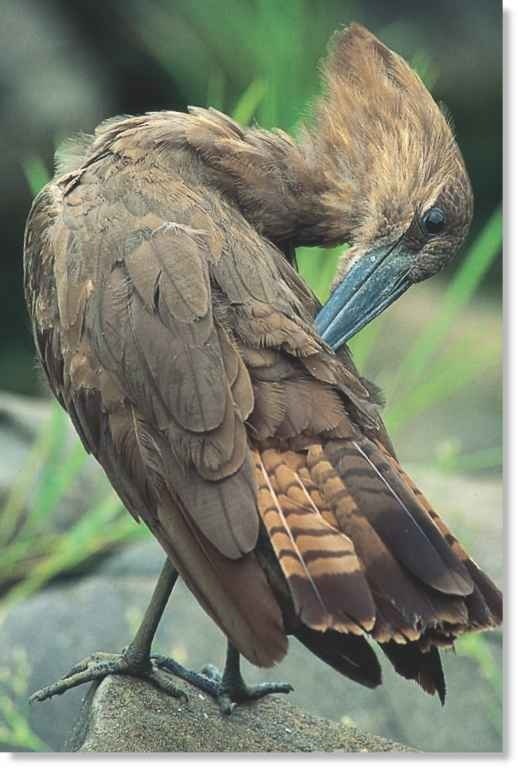ORDER
Ciconiiformes
FAMILY
Scopidae
GENUS & SPECIES
KEY FEATURES
• A strange wading bird that builds a huge nest, with a roof strong enough to support the [weight of a-man
• Normally silent and solitary, it indulges in a-bizarre and noisy “back-standing” ritual when in the company of-neighbors
• An important feature of many tales in African folklore, often appearing as a bird of ill omen
WHERE IN THE WORLD?
Throughout Africa, south of the Sahara Desert; also breeds on Madagascar, and in an area of southwest Arabia bordering the southern shores of the Red Sea
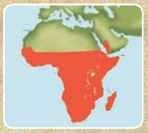
Lifecycle
In tribal legend, the hamerkop uses magical powers to conjure various creatures from its gigantic nest. In reality, other animals are indeed found there — but not by invitation.
HABITAT
The hamerkop occurs near shallow water, from the edges of large lakes to-the banks of small streams. It also lives in grasslands and semiarid plains, and in coastal regions it is found on mudflats
in estuaries, mangrove swamps and rockpools. The hamerkop can also survive in reservoirs, farm ponds and rice paddies.
Paddling paradise The hamerkop favors wooded areas near rivers.
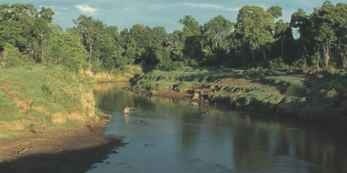
BEHAVIOR
Although not normally gregarious, the hamerkop sometimes forms small groups to indulge in a unique and unexplained aspect of its behavior Known as false-mounting, it involves birds of either sex repeatedly jumping on each others’ backs.This bizarre ritual seems to have nothing to do with mating, but may be a means of social interaction. The performance is accompanied by a loud cackle. False-mounting is preceded by head-bobbing and wing-beating ceremonies, similar to those used in courtship.
Flocks of nonbreeding birds may congregate at roost sites in trees or reedbeds. The hamerkop has a peak of activity at dawn and shortly before going to roost at sunset. It spends much of the day resting in shade.
The hamerkop does not migrate, and mated pairs remain within their breeding territories throughout the year.
Fishing by sight A hamerkop pair scans for fish and frogs.
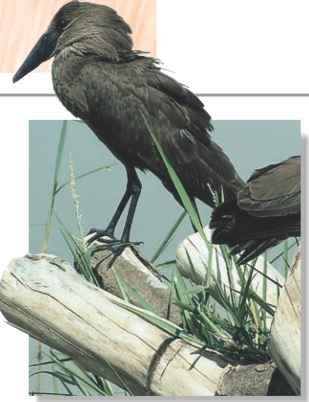
Pigeons and geese use abandoned hamerkop nests as breeding sites. Smaller birds, and even bees, breed in-crevices
in the nests even while the hamerkops are in-residence.
The hamerkop often decorates the roof of its nest-with bones, dead animals-and snake skins.
A hamerkop pair may build as many as five nests in-a year. It may occupy some-nests for a few months, while others remain unused for the whole year.
BREEDING
The hamerkop’s nest is a massive monument to its building skills, yet often seems a waste of energy: owls frequently commandeer the fortresslike nest before the rightful owners can use it. This may explain why hamerkops are almost always constructing new nests.
The nest is usually sited in the fork of a tree (far right), and can be over 6′ tall-and almost as wide, with l2″-thick walls and a 3′-deep roof. Entry is by way of a hole in the base, through which the hamerkop rockets after closing its wings at the last second. The female lays 3-6 white eggs, but lizards,mongooses and snakes prey heavily on eggs and nestlings. Such losses leave the hamerkop with a low reproduction rate. A pair rarely raises more than one chick a year, and many a brood has been known to fail completely.
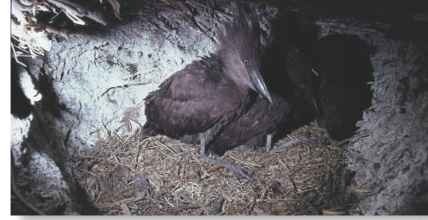
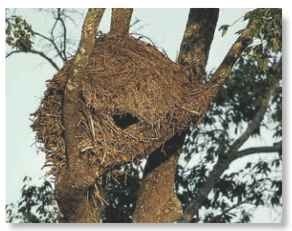
FORTRESS INATREE FORK
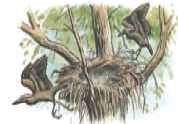
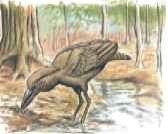
Foundations & Cements
A pair begins its nest by making A hamerkop collects mud, mixes it
a flat platform of long sticks. The with grass and leaves, and smears
birds then add more branches to the paste onto the nest; the
build up solid wooden walls. mixture acts as cement.
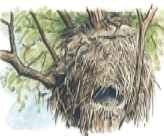
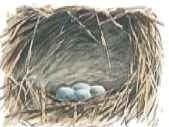
Roof & Housing
After finishing the walls, the pair The structure houses a mud-builds a huge roof.The birds lined nesting chamber roughly usually gather nest-building 24″x16″. The eggs are soon material within 300′ of the site. stained brown with mud.
CONSERVATION
A traditional belief in many parts of Africa —that disaster will befall anyone who harms a hamerkop — has kept the species free from persecution. Secure in the feeling that it will not be harmed, it-often lives close to humans. Here it-finds better feeding and breeding conditions than in many areas of its more natural habitat.
FOOD & FEEDING
The hamerkop feeds on tadpoles, frogs and fish, and supplements its diet with small crustaceans. It catches some food by probing in mud with its large bill, but locates many items by sight. When the water is too deep for wading, the bird may ride on a hippopotamus or launch an airborne attack. It flies low and slowly, picking out tadpoles and tiny fish from just below the surface. The hamerkop also stirs up mud with its feet, pecks and pulls at floating plants or rapidly opens and closes its wings in the hope that the sudden movement will frighten prey out of hiding.
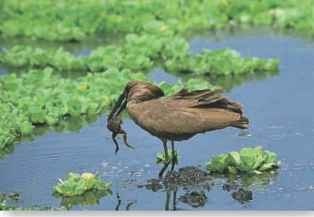
A Doused bullfrog
The hamerkop rinses muddy prey before eating.
PROFILE
Hamerkop
With its big bill and matching crest, the hamerkop often looks large in photos, but it is much smaller than many more-familiar herons.
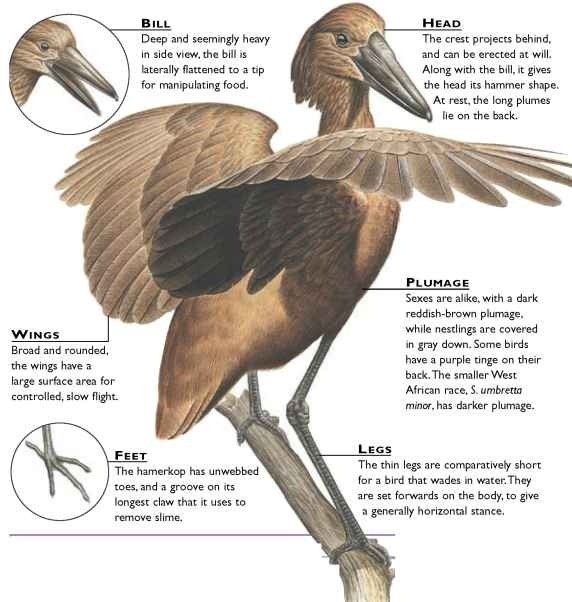
CREATURE COMPARISONS
The boat-billed heron (Cochlearius cochleahus) of South and Central America is in many ways as unusual as the hamerkop. A large-eyed nocturnal bird, its most extraordinary feature is its bill, which is just 3″ long but 2″ wide and almost the same in depth.The boat-billed heron emerges at night to scoop up fish and shrimp from mangrove swamps, coastal rivers, lakes and marshes. Unlike the hamerkop, it builds a small nest of leafy branches or uses the nest of another species. In courtship, it fans its drooping Jplack crest, claps its bill and croaks like a frog.
Hamerkop
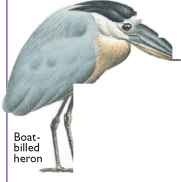
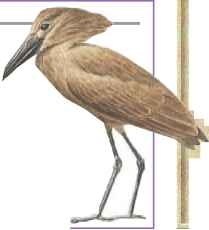
| STATISTICS | |
| Weight | 14.5-16 oz. |
| Length | 20-22″ |
| WlNGSPAN | 30-32″ |
| Sexual ; Maturity | Unknown |
| Breeding Season Number i of Eggs |
Year-round, with seasonal peaks 3-6, rarely 7 |
| Incubation Period | 28-32 days |
| Breeding Interval | 1 year |
| Fledging Period | 44-50 days |
| Typical . Diet | Frogs, fish, crustaceans and-insects |
| Lifespan | Unknown |
RELATED SPECIES
• The hamerkop, the only-member of the genus Scopus, is placed in its own family. It has a number of unique characteristics and others that link it to herons, flamingos and storks, including the rare shoebill stork, Balaeniceps rex, of Africa. When soaring, the hamerkop extends its-neck rather like a stork, but in normal flight-it more closely resembles a heron, with its neck partly retracted.
